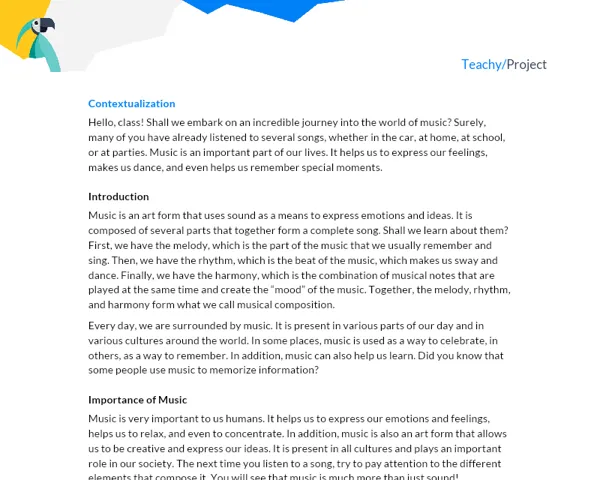Contextualization
The art of theatrical representation is a complex and multifaceted manifestation that involves various elements and techniques. Among them, scenic elements stand out - vital components for the effective construction and transmission of the story to the audience. They encompass the set, costumes, lighting, sound design, among other aspects. Each of these 'ingredients' carries an immeasurable importance for the entirety of the theatrical work and has the power to directly influence the audience's interpretation.
Scenic elements shape the visual language of the play, communicating the era, location, emotional climate, personality of the characters, and many other aspects that help in creating the theatrical atmosphere. They are the visual parameter through which the story will be told and offer actors a material reality with which they can interact. Without them, the presentation would simply be a read-through of the script.
However, scenic design is not simply about adding objects to the stage - each component needs to be carefully selected and positioned in a way that contributes to the whole of the theatrical piece. Scenic design is an art form in itself, requiring a deep understanding of the story being told, the characters that inhabit it, and the type of experience intended for the audience.
Theatrical representation is more than a form of entertainment - it is an artistic expression that reflects the society, culture, and values in which it is produced. It has the power to provoke reflections, inspire emotions, and convey powerful messages. Therefore, understanding scenic elements is crucial for anyone wishing to delve into the understanding of theatrical art.
In the contemporary world, scenic elements are used not only in theater but also in films, television programs, music videos, and even live events such as concerts and fashion shows. They are an indispensable tool for anyone working in production design, artistic direction, and set design. Mastering this facet of theatrical art opens doors to a variety of careers in the entertainment industry and visual arts.
As resources for further exploration on the subject, we suggest the use of the following materials:
-
Book 'An Actor Prepares' by Constantin Stanislavski. Available in libraries or for purchase in physical and online bookstores.
-
Book 'The Empty Space' by Peter Brook. Available in libraries or for purchase in physical and online bookstores.
-
Internet research on the greatest scenographers in the history of theater, such as Adolphe Appia, Edward Gordon Craig, and Josef Svoboda.
-
YouTube videos on the production of theatrical plays, films, and television programs.
Practical Activity
Activity Title: Building a Mini Theatrical Set
Project Objective: Understand the importance and relevance of scenic elements for theatrical representation; develop teamwork, time management, creativity, communication, and problem-solving skills.
Detailed Project Description:
Groups must work together to create a mini theatrical set, incorporating various scenic elements such as lighting, props, costumes, and sounds. They must select a play or a passage from a book they would like to adapt and then plan and build the set for that story.
Students should document the entire creative process, from the initial planning to the final construction of the set. They should reflect on how the different elements combine to create a theatrical atmosphere and how these components contribute to the audience's interpretation of the story.
Materials Needed:
- Cardboard Box
- Colored Paper
- Scissors
- Glue
- Pens and Colored Pencils
- Fabrics
- LED Lights
- Small Speaker (optional)
- Various materials for decoration (sequins, glitter, etc)
Step-by-Step:
- Form groups of 3 to 5 students.
- Select a play or a passage from a book to adapt.
- Brainstorm about the set and the different scenic elements that could be incorporated in the adaptation.
- Plan the set, drawing an initial sketch.
- Gather the necessary materials for set construction.
- Start building the set, remembering to document the entire process.
- Upon completion, each group must present their set to the class, explaining the choices made for each scenic element and how they contribute to the story.
Project Deliverables:
In addition to the constructed set, groups must submit a written report detailing the creation process. The report should be divided into four main parts:
-
Introduction: The report should begin with a summary of the project, including the objective, the chosen play or book passage, and a brief description of the scenic elements.
-
Development: Here, students should elaborate on the creative process. They should explain their choices for each scenic element, how they integrate into the set, and contribute to the story. It is also important to describe the challenges encountered during the process and how they were overcome.
-
Conclusion: In the conclusion, students should reflect on what they learned during the project. They can discuss how teamwork and creativity were important for the project's success, and what skills they developed or improved.
-
Bibliography: Finally, students should include a list of all information sources used during the project. This may include books, videos, websites, and any other materials that helped in the creation process.
Each group will have one week to complete the project. Remember that the quality of the written report will be considered in the final evaluation, as well as the quality and creativity of the constructed set.

